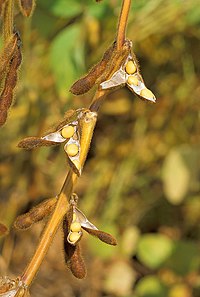
Photo from wikipedia
A recombinant inbred line population of soybean ( Glycine max ) was utilised to identify the quantitative trait loci (QTLs) determining the response to infection by two root-knot nematode species,… Click to show full abstract
A recombinant inbred line population of soybean ( Glycine max ) was utilised to identify the quantitative trait loci (QTLs) determining the response to infection by two root-knot nematode species, Meloidogyne incognita and M. hapla , in glasshouse assays. QTL analysis detected seven major and four minor QTLs on seven soybean chromosomes ((Chrs) 1, 7, 8, 10, 14, 18, 20) explaining 6-41% phenotypic variance (PVE) for M. incognita root response and nematode reproduction. Three of the major QTLs, on Chrs 7, 10 and 18, were confirmed in previous reports and two major QTLs on Chrs 14 and 20 were detected for the first time. The QTL analysis with M. hapla provides the first report of a major QTL region mapped on Chr 7, explaining 70-82% PVE in M. hapla root response and nematode reproduction. These novel identified QTLs with flanking markers will be helpful in marker-assisted breeding for nematode resistance in soybean.
Journal Title: Nematology
Year Published: 2018
Link to full text (if available)
Share on Social Media: Sign Up to like & get
recommendations!